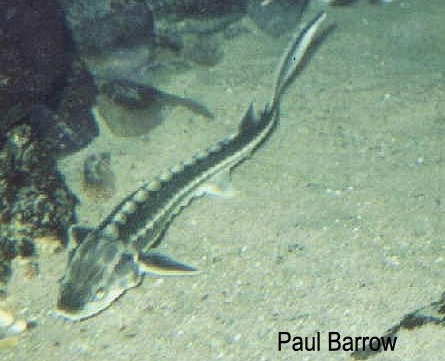
Common Name(s):
Sturgeon
Scientific Name:
Acipenser sturio.
Usual Size:
to 345cms.
UK Record Weights from rod/line:
Shore:
Boat:
MAFF Minimum Size: Shore: Boat:
 |
Fact File:
Common Name(s): Scientific Name: Usual Size: UK Record Weights from rod/line: Boat: MAFF Minimum Size: Shore: Boat: |
| Identification: a primitive, scaleless fish with an under-slung mouth. The body is long and tubular and bends upwards at the caudal peduncle to follow the upper lobe of the tail. Its head a triangular and flattened from above. Bony plates protect the gill covers and throat region. Four barbels are situated just ahead of the protrusible mouth. There are five rows of bony scutes running along the body: two along the underside from the pectoral fins to the anal fin, two along the lateral line from the head to the tail and a single row along the back from between the eyes to the dorsal fin. The dorsal, pelvic and anal fins are situated in the rear third of the body. The caudal fin is asymmetric with the upper lobe about twice as long as the lower. Colour varies from dark brown to green above to light brown to white below. All scute are lighter in colour then the rest of the body. Breeding: Habitat: Food: Range: Additional Notes: |
Return to the